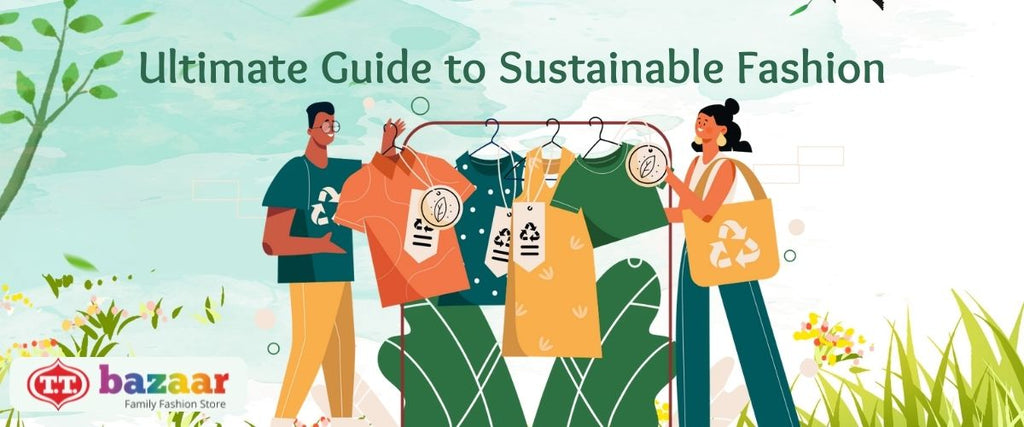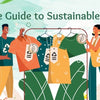TT Bazaar Ultimate Guide to Sustainable Fashion

Sustainable Fashion - the term has created a buzz these days. But what does it actually mean? And what are eco-conscious or ethical fashion brands look like? In short, the term, sustainable fashion, is primarily used to describe clothes that are created and consumed in a way that can be sustained while protecting the environment. True sustainability needs a holistic approach toward the environment and society. The fashion industry is one of the most polluting industries in the world, causing significant harm to the environment and human health. Sustainable fashion is a sort of shift towards materials that are kinder to the environment and better for humans. While there are plenty of brands who admit that there’s room for improvement, only a few of them are currently tackling these complex issues. Going sustainable doesn’t just mean shopping for items labeled “Sustainable”, rather we should rethink our shopping habits and the way we consume clothes.
So, are you eco-conscious? Scroll down the page and find an ultimate guide by TT Bazzar that ensures your wardrobe is as sustainable as possible.
Why does Sustainable Fashion Matter?
The fashion industry is one of the most rapidly growing industries in the world, and with that growth comes an increased demand for sustainable clothing options. Here, we’ll explore some of the reasons why sustainable fashion is such a big deal, and why you should pay attention to this approach.
It saves natural resources
With less fabric used and fewer chemical ingredients, sustainable fashion is more environmentally friendly than traditional fashion. It’s also good for the planet because it eliminates the need to produce vast numbers of products that will eventually end up in landfills.
It reduces carbon footprint
Sustainable fashion is an important part of reducing the carbon footprint. According to the UN, clothing accounts for about 8 - 10 percent of global carbon dioxide emissions. By buying sustainable fashion, consumers can help reduce the amount of pollution produced by clothing production.
It supports safer work conditions
It is important to note that, while the fashion industry has made strides in reducing environmental impacts, there is still much work to be done. Sustainable fashion helps make sure that workers are treated fairly and have a safe and healthy work environment. For example, sustainable fashion practices often involve using sustainable materials such as organic cotton. This means that the fabric does not contain harmful chemicals or toxins, which helps keep workers safe.
A Complete Guide to Sustainable Fashion
When it comes to fashion, sustainability is key. But what does that really mean for the average person? To cut through the clutter, TT Bazaar has outlined a complete guide to following a sustainable fashion approach. Check them out and join the club to save the environment.
1. Embrace natural materials
Not all materials you are purchasing need to be synthetic; sometimes nature provides us with the perfect solution. For example, cotton is a natural fiber that's environmentally friendly and comfortable to wear. Plus, many sustainable fabrics have been made using organic materials instead of harsh chemicals. Choose natural dyes and finishes when possible. These products don’t use harsh chemicals, which can have harmful side effects on the environment and human health. Some natural dyes include beet juice, turmeric, and madder root.
2. Look for labels that certify an item as sustainably made
There are many reputable organizations that certify sustainable clothing, such as GOTS (Greensustainable Trade Initiative), which is the leading certification scheme for sustainable products. When you're shopping for sustainable clothing, be sure to look for brands that use environmentally friendly materials. Be sure to ask the brand how it's doing impact-wise - is it partnering with organizations that are working to reduce environmental harm? It’s important to look for brands with eco-friendly policies and social responsibility initiatives.
3. Avoid Greenwashing
There's a big problem with sustainable fashion: it's often greenwashed. "Greenwashing" is the process of advertising or promoting something as environmentally friendly or sustainable when in fact it may not be. When you're shopping for sustainable fashion, make sure to look for labels that use the term "sustainably made." This means that the clothing was produced using sustainable methods, without compromising the garment's quality or safety. Always ask questions about the sustainability of a particular piece of clothing before you buy it.
4. Invest in second-hand or vintage clothing
If you're looking to invest in sustainable fashion, consider picking up some second-hand clothes and vintage pieces. By buying used or vintage items, you're supporting the sustainable clothing industry, which often employs disadvantaged people in developing countries. Additionally, you can score some great deals by shopping at thrift stores or consignment shops. Not only is this a great way to save money, but it also helps reduce the amount of waste that's produced each year. Plus, when you buy vintage or secondhand items, you're helping to preserve history and support small businesses.
Summing Up
Sustainability is something that we should all be striving for. Not only does it make good business sense, but it's also the right thing to do. And when it comes to fashion, sustainability is key. So, whether you’re looking to reduce your environmental impact or just want to look good while doing so, by following these guidelines you will be on your way to becoming a more responsible fashion consumer.




